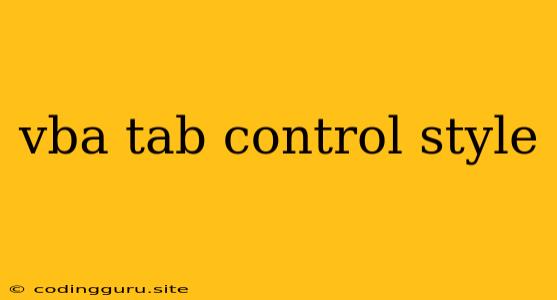Mastering the VBA Tab Control: A Comprehensive Guide
The VBA Tab Control is a powerful tool for organizing and presenting information within your Excel applications. It allows you to switch between different sets of data or functionalities easily by simply clicking on different tabs.
This guide will explore the basics of using the VBA Tab Control, from creating and customizing it to managing its properties and events.
Understanding the VBA Tab Control
The Tab Control, found in the "Controls Toolbox" within the Developer Tab, is a versatile component that can significantly enhance the user interface of your VBA projects. It provides a structured way to organize multiple controls, forms, or user interfaces within a single window.
How Does it Work?
Think of a Tab Control as a container that can house multiple "pages" or "tabs". Each tab can contain its own set of controls, data, or functionalities. Users navigate between these pages by clicking on the corresponding tabs.
Creating and Customizing the Tab Control
1. Adding the Tab Control
- Ensure the Developer Tab is activated in your Excel ribbon.
- Click the "Controls Toolbox" icon.
- Select the "Tab Control" from the list.
- Click and drag on your worksheet or user form to create the Tab Control.
2. Adding Tabs
- Right-click on the Tab Control.
- Choose "Properties".
- Navigate to the "Tabs" section.
- Click the "Add" button. This creates a new tab within the control.
3. Customizing Tabs
- Rename tabs to something meaningful by changing the "Caption" property in the Properties window.
- Modify the "BackColor", "ForeColor", and "Font" properties to customize the appearance of individual tabs.
Managing Tab Control Properties and Events
1. Properties
The Tab Control's Properties window offers a comprehensive set of options for controlling its behavior and appearance. Some important properties include:
- "Enabled": Determines if the Tab Control can be interacted with.
- "MultiSelect": Allows selecting multiple tabs simultaneously.
- "TabIndex": Determines the tab order for navigation.
- "Style": Determines the look of the tabs.
2. Events
You can use events associated with the Tab Control to trigger specific actions when users interact with it. Common events include:
- "Change": Triggered when the active tab is changed.
- "Click": Triggered when a specific tab is clicked.
- "GotFocus": Triggered when the Tab Control receives focus.
- "LostFocus": Triggered when the Tab Control loses focus.
Illustrative Examples
1. Simple Tabbed User Interface
Private Sub UserForm_Initialize()
Dim tabControl As MSForms.TabControl
Set tabControl = Me.TabControl1
' Add tabs
tabControl.Tabs.Add
tabControl.Tabs.Add
' Set tab captions
tabControl.Tabs(1).Caption = "Data Entry"
tabControl.Tabs(2).Caption = "Reports"
' Place controls on each tab
' ...
End Sub
2. Switching Between Forms
Private Sub TabControl1_Change()
Dim tabIndex As Integer
tabIndex = Me.TabControl1.TabIndex
Select Case tabIndex
Case 1
' Load Form1
Form1.Show
Case 2
' Load Form2
Form2.Show
End Select
End Sub
Conclusion
The VBA Tab Control is a valuable tool for creating user-friendly and organized Excel applications. By understanding its features and capabilities, you can effectively implement it to improve the efficiency and aesthetics of your VBA projects. Remember to experiment with different properties and events to discover how you can best leverage this powerful tool for your specific needs.
